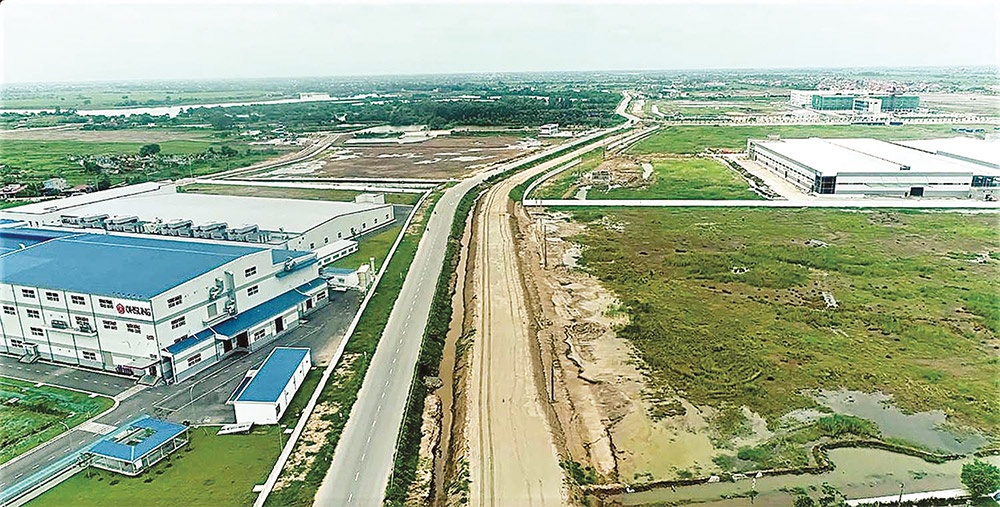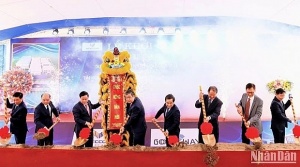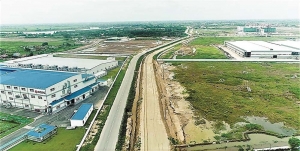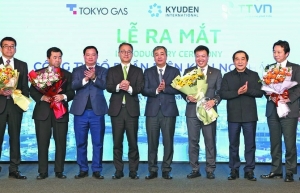Thai Binh targeting modern development
 |
| Efforts are being made to attract more investments into industrial zones in Thai Binh province |
A key point in Thai Binh’s planning towards 2030, with vision towards 2050, unveiled to the public on March 5 in the province, is transforming Thai Binh Economic Zone (EZ) into the new growth driver to spur development of the province and the whole Red River Delta region.
The ocean space is deemed a vast advantage of Thai Binh. The development planning of diverse functional areas in the province’s fresh scheme for the rest of the decade rules that Thai Binh EZ shall develop in a multi-sector direction, empowered by modern and seamless infrastructure, and bridging industrial development with the urbanisation process of relevant locations.
Priority shall be given to the development of diverse industrial, urban, and services complexes north of Thai Binh EZ and the establishment of high-tech and non-carbon industrial and related complexes in sea-encroached areas.
Efforts shall also gear towards forming and developing already-approved industrial zones, such as building a modern and synchronised biopharmaceutical zone that can entice investors into the field.
Thai Binh’s new scheme also indicates the development of a system of almost 70 industrial clusters over an area of 4,200 hectares in diverse districts, forming a number of specialised and manufacturing clusters in the multi-sector and regional linkage approach.
To best avail of the space, the new planning has set a specialised zone for forestry development to cover around 5,390ha, including almost 2,100ha of protective forests and 2,250ha of special-use forests.
The coastal areas are held accountable to preserve and sustainably use local important natural ecosystems. Along with this, Thai Thuy and Tien Hai land-immersed nature reserves are planned for local biodiversity conservation to minimise the consequences of natural phenomena like storms and high tides, serving as the green lung along Thai Binh’s long-stretching coastline.
Thai Binh’s six-mile sea space across nearly 500 square kilometres is designed to propel the development of seaports and logistics, aquaculture, marine resource exploitation, renewable energy, and tourism development, while sea-encroached areas are targeted for urban and industrial development.
The space shall accommodate Diem Dien, Tra Ly, and Ba Lat ports to be accessible to vessels with carrying capacity reaching 50,000 tonnes, along with building two dry ports located north and south of Thai Binh EZ. The scheme also envisions wind power development in areas close to Con Den Resort and next to the Tra Ly Estuary, along with building a 70MW wind farm.
Thai Binh shall also embrace inclusive multi-offering sea-based tourism development, encompassing the Thuy Truong salt-marsh forest eco tour, Con Vang-Con Thu golf course tour, Con Den ocean tour, Dong Chau coastal resort, and more.
The space south of Thai Binh EZ will be prioritised for marine ecological urban development, combining industry, trade and services, and ecological urban development with tourism and wind power, as well as natural landscape conservation.
The planned sea-encroached area of just over 4,420ha aims to expand the available land for the province’s socioeconomic development.
Thai Binh shall house three expressways, of which the CT.16 route is to connect Thai Binh EZ with the Tra Giang urban area and Thai Binh city with the capital’s northwest EZ, and other localities in the central and southern regions.
After 2030, when the associated infrastructure has been completed, Thai Binh will form a dual-use airport with helicopter landing points and coastal landing sites for seaplanes.
Efforts also involve furthering oil and gas exploration at offshore potential areas; building and ensuring stable operation of the Ham Rong and Thai Binh gas field gathering and distribution systems; building a condensate processing plant at Thai Binh EZ; building a liquefied natural gas thermal power centre; and expediting a raft of renewable energy projects on onshore and offshore wind, rooftop solar, and biomass power development. This all sits alongside building new power stations and transmission lines of diverse voltage levels to catch up with ever-surging local power demands.
In addition, the new scheme has allocated the development of a 1,000-ha research and training area in Quynh Phu district to grow into a scientific research training centre for the region and beyond, aiming to pull in experts from high-tech industries to carry out research, application, and training.
| Ngo Dong Hai, secretary, Thai Binh Party Committee
Thai Binh’s planning has been meticulously and methodically studied, leveraging a complete information and data system, helping to make objective and accurate assessments about the current status as well as the province’s potential and development capabilities to ensure feasibility during the implementation process. This milestone is of special significance to everyone in Thai Binh because the approved planning is the legal basis and motivation for the province to exploit its potentials and advantages, and materialise the goals, tasks, and breakthroughs enshrined in the set resolutions. Thai Binh has a sound trust about the feasibility of the goal to turn the northern province into a developed locality in the Red River Delta region. The Party and all people in Thai Binh are proud of the breakthrough achievements the province has scored in the past three years, simultaneously preparing the prerequisites instrumental for Thai Binh to leapfrog in the forthcoming years. Nguyen Khac Than, chairman, Thai Binh People’s Committee
To turn Thai Binh into a thriving land, the province’s planning features four growth pillars, three breakthroughs, four development spaces, three economic corridors, and well-conceived sector-based development orientations. The four growth pillars are, firstly, effectively availing the province’s long-lasting tradition in agriculture while building a modern, productive, quality, effective, and sustainable agricultural commodity production system. Second is building Thai Binh into a modern industrial centre, aiming to become the leading industrial and energy centre in the Red River Delta. Third is building green, beautiful, and liveable urban areas; and fourth is comprehensively developing Thai Binh Economic Zone into the core and main driving force of the province, while preparing conditions to expand development space towards the sea. With strategic vision, the new planning has concretised the development aspirations, availing of all potentials, resources, advantages, and human factors to bring Thai Binh into rapid, comprehensive, and sustainable development. The goal is that by 2030, the province will become a fairly developed locality and a robust industrial development centre for the Red River Delta. By 2050, Thai Binh shall turn into a developed locality, with a prosperous economy, progressive society, and a wholesome ecological environment. |
 | Taiwanese firm breaks ground on 45 mln USD computer plant in Thai Binh Good Way Cayman Co. Ltd. from Taiwan (China) held a groundbreaking ceremony for a large-scale plant manufacturing computers and their peripheral equipment at the Lien Ha Thai Industrial Park in the northern province of Thai Binh on February 19. |
 | Thai Binh eyes more foreign investors According to the General Statistics Office, Thai Binh currently ranked fifth nationwide in luring foreign investment, with nearly $3 billion seen in 2023. |
 | Thai Binh to host $2 billion LNG project The Thai Binh liquefied natural gas (LNG) project is located in Thai Binh Economic Zone, and will have a designed capacity of 1500MW. The investment consortium behind the project is responsible for nearly $2 billion in funding and consists of Tokyo Gas, Kyuden, and Truong Thanh Vietnam Group. |
What the stars mean:
★ Poor ★ ★ Promising ★★★ Good ★★★★ Very good ★★★★★ Exceptional
Related Contents
Latest News
More News
- Global partnerships key to Vietnam’s IFC development (December 26, 2025 | 16:18)
- Vingroup pulls out of bid to invest in North-South high-speed railway (December 26, 2025 | 11:42)
- Strengthening supply chains through trade promotions and customs reform (December 24, 2025 | 14:00)
- PM orders investment model for North–South high-speed rail (December 22, 2025 | 17:43)
- LS Eco Energy to invest in Vietnam rare earth sector (December 22, 2025 | 17:31)
- Government moves to establish International Financial Centre (December 21, 2025 | 21:00)
- Vietnam's IFC to target global investment flows (December 21, 2025 | 18:00)
- Two national hospitals expand capacity with new facilities (December 20, 2025 | 09:00)
- Ha Tinh breaks ground on major Vingroup industrial and energy projects (December 19, 2025 | 18:24)
- EVN launches major power infrastructure projects nationwide (December 19, 2025 | 18:17)



 Tag:
Tag:





















 Mobile Version
Mobile Version